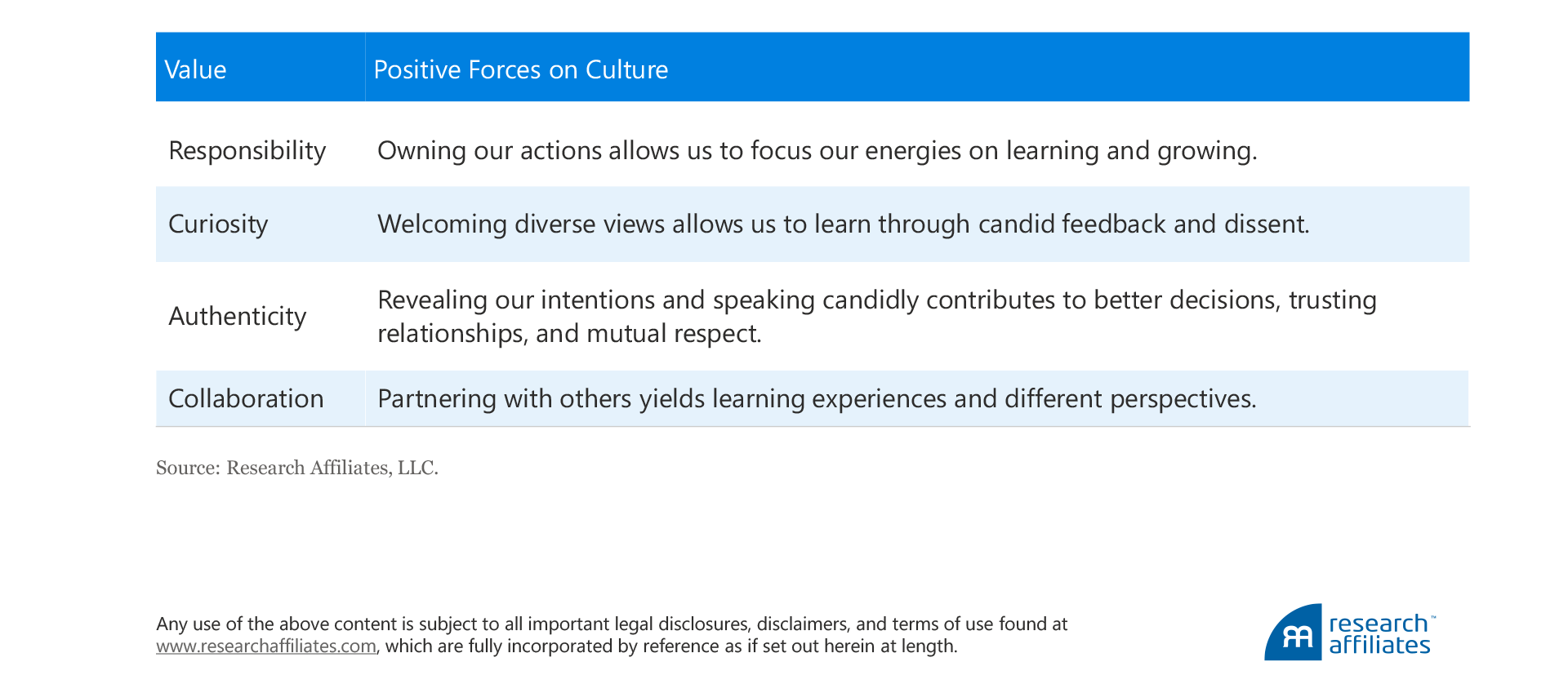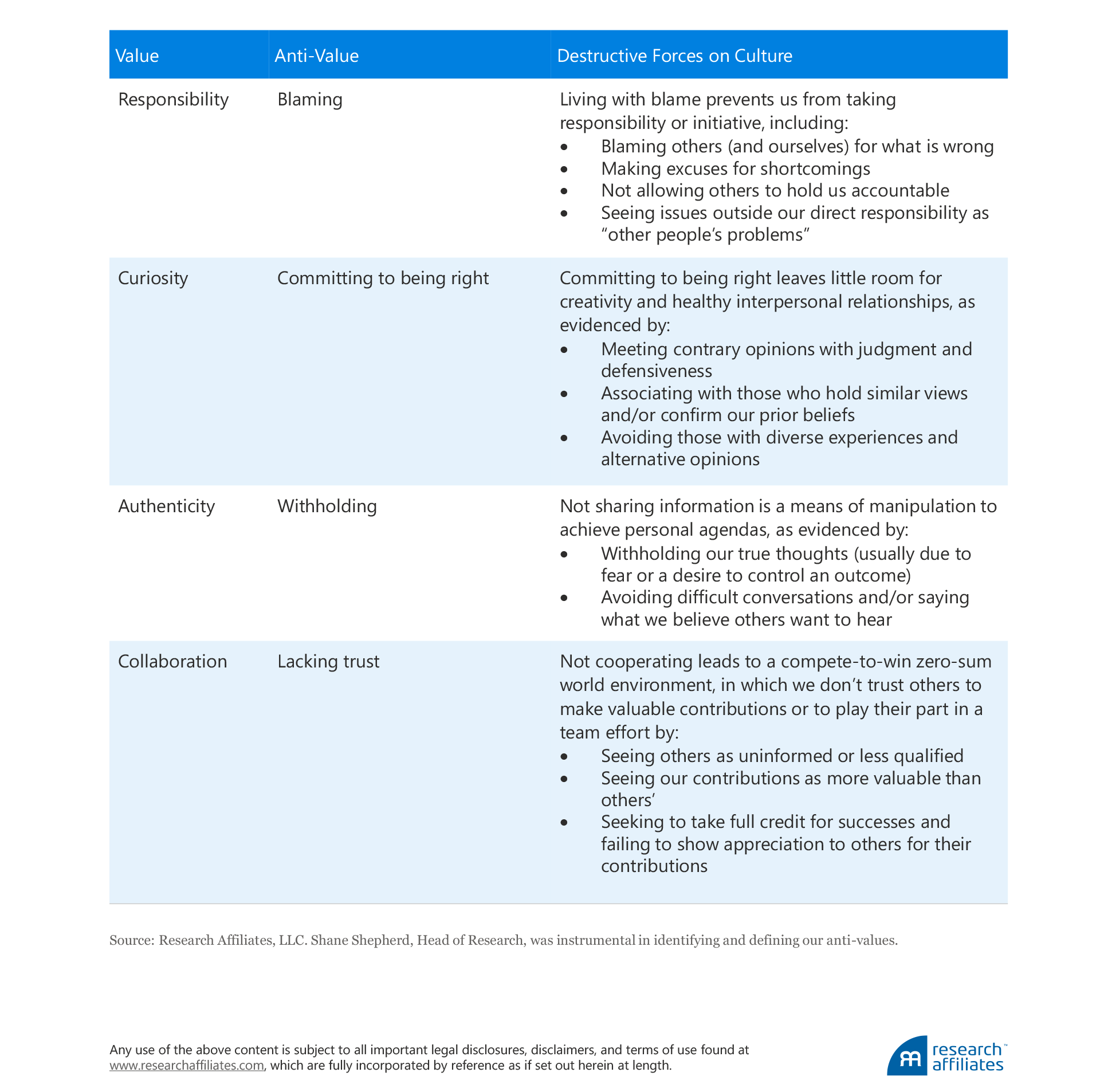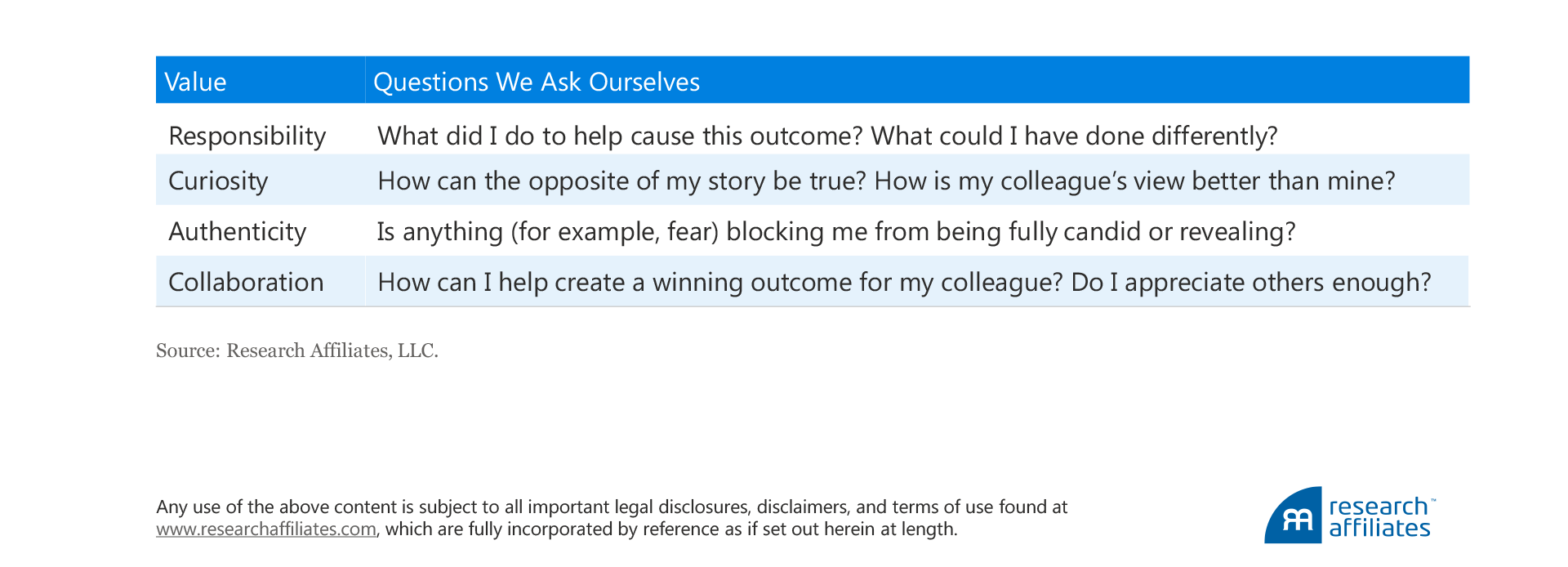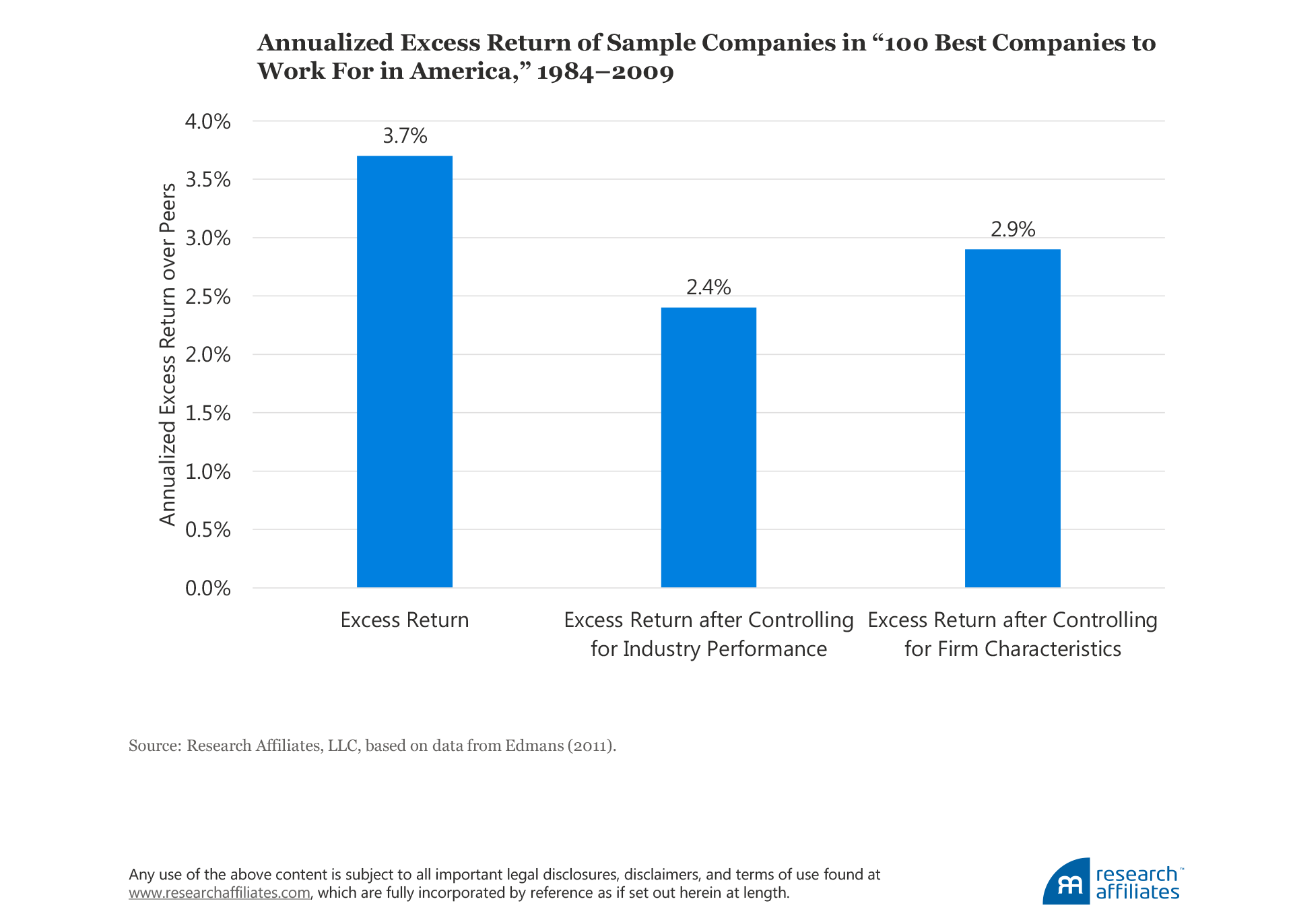
At Research Affiliates, our winning formula focuses on mission, culture, and team.
We believe a corporate culture that supports the development of its employees will in turn contribute to the long-term success of clients, partners, and the firm itself.
We believe a firm’s culture is essential to fostering high-functioning teams and raising firm and team levels of collective intelligence.
We build our culture around the aspirational values of responsibility, curiosity, authenticity, and collaboration rather than the potentially destructive anti-values of blaming, committing to being right, withholding information, and lacking trust in others.
Abstract
Our recent CEO transition has provided an opportunity for us to reflect on what makes Research Affiliates successful. The winning formula for Research Affiliates is a team of skilled and competent people, each of whom embodies the values of our culture, working together in a curious and collaborative approach to achieve our firm mission. We believe that when our team is aligned by an inspirational mission and thrives in an inclusive culture, which deliberately strives to improve the firm’s level of collective intelligence, we are well positioned to achieve win-win-win outcomes—that is, a win for our end investors, a win for our distribution partners, and a win for ourselves.
We recently announced a governance change—I was named CEO when Rob Arnott chose to embrace the role of non-executive chair. In anticipation of the inevitability of such a leadership transition, Rob, I, and the other partners in the firm set out more than 10 years ago to be more intentional about building a culture at Research Affiliates that would support great outcomes for decades to come for our clients, partners, and employees, regardless of the specific individual holding the title of CEO. Naturally, we’ve received questions in the wake of the announcement: What is different at Research Affiliates? What is the same? Does Research Affiliates still have a winning formula? These questions piqued my curiosity too, but because I knew what we had achieved after a lot of hard work, I felt pretty comfortable I knew the answer.
On the surface, Rob Arnott, our chair and past CEO, and I are very different. If you’ve met us or quickly glanced at the About Us page on our website, this is quite obvious. I have red hair; he doesn’t. He has a beard; I don’t. I have a PhD; he doesn’t (but he is a much more prolific and respected author than most PhDs). He’s a well-known quantitative investment manager, I am not. My expertise is in management and leadership, which Rob will readily tell you he enjoys less than research and managing portfolios. And the list goes on…. Clearly, we differ on many dimensions.
We also have many similarities, which may not be evident in the way we describe ourselves in the About Us section. We share, for example, a deep love of learning and the role of evidence in evaluating alternatives, and we thrive in an entrepreneurial environment, where we have the opportunity to build a business in our own model. We respect the process of collaboration and the value of diverse opinions—yes, even when the opinions are contrary to our preconceptions (and biases)—in large part because we appreciate the benefits of cognitive diversity.
Most important, we are both committed to what we view as the winning formula of firm management, and that is a commitment to our mission, our culture, and our people. Each element of our winning formula is essential to achieving what we call win-win-win outcomes: a win for our end investors, a win for our distribution partners, and a win for ourselves. We believe that attaining a triple-win requires a team of skilled and competent people, each of whom embodies the values of our culture, working together in a curious and collaborative approach to achieve our firm mission.
Our Mission
Research Affiliates is committed to being the preeminent source of insights and products that transform the global investment community for the benefit of investors.
The Elements of a Winning Formula
The first element of Research Affiliates’ winning formula is mission. A firm’s mission defines its purpose for being, which we believe should be both meaningful and authentic—one that provides a clear, credible definition of what the firm does. Just as importantly, a firm’s mission should be inspirational—a purpose that unites its employees in pursuing a shared forward-looking vision, corporate strategy, and portfolio of tactical decisions. In fact, we believe the mission should be so inspirational and all-embracing that it resonates across all workforce generations.
The second element of our winning formula is culture. We are devoted to creating a sustainable culture that lives and breathes our core values and focuses on helping our employees grow and develop, which we believe in turn creates a virtuous cycle that benefits our clients, partners, and firm.
This brings us to the third and last component of our winning formula: team. Hiring people who sign on to the mission and developing all of our employees are crucial activities in building a team of people with strong skills and cognitive diversity. But, skills and cognitive diversity alone are not enough to reap the potential benefits of team decision making. For a team to improve its odds of making optimal decisions, the firm culture must allow dissent and candor to thrive within the team (Sherrerd, Treussard, and Wu, 2018).
Bringing these three elements together, we believe that when our team is aligned by an inspirational mission and thrives in an inclusive culture, which deliberately strives to improve the firm’s level of collective intelligence, we are well positioned to achieve win-win-win outcomes. Accordingly, we are intentional in creating an inclusive environment where people are comfortable offering dissenting opinions, because our colleagues understand they are contributing even if they may prove to be wrong! As Nemeth (1986, p.23) has shown, minority dissenting views—even if wrong—add value because they “stimulate divergent attention and thought….They contribute to the detection of novel solutions and decisions that, on balance, are qualitatively better.” Essentially, any approach that offsets unconscious biases, so they are less of a barrier to optimal group thinking, can improve outcomes. Therefore, we deliberately seek to adopt collaborative decision-making processes to help uncover our blind spots and biases and to ensure we make timely decisions that reinforce our mission and our commitment to clients and partners.
Our Culture and Values
The influence of firm culture is far deeper and impactful than most realize. Culture enables people to succeed and to grow both professionally and personally. We can take this idea a step further. Beyond supporting the development of individuals, a firm’s culture is essential to fostering high-functioning teams and raising firm and team levels of collective intelligence.
The essence of a culture can often be found in a firm’s core values. Our culture focuses on a set of employee-centric values that fosters inclusion, trust, and respect. These values include responsibility, curiosity, authenticity, and collaboration. To illustrate how our values strengthen the firm and influence the decisions we make, let’s explore both the aspirational objective of each value and its opposite, or anti-value, before I explain how our values in combination guide us in accomplishing our strategic goals and objectives.
When we take responsibility, we own the outcomes of our actions—both good and bad. We believe each of us is 100% responsible, no more and no less, for our contribution to an outcome. Take, for example, a typo in this article. While it might be tempting to deflect blame from me, the CEO, to the copyeditor for not picking up my mistake, that behavior is not consistent with our values. Rather, I need to take responsibility for my role in the error as does the copyeditor AND everyone else who read the drafts and did not catch the error. Note, it is just as bad for me to “hero” the team and take more than 100% responsibility (i.e., taking both my and their responsibility). Rising above blame and finger-pointing allows us to devote our attention and energy to the lessons learned and new perspectives gained.
When we are genuinely curious, we embrace independent views and are eager to understand our colleagues’ viewpoints. We welcome feedback—both positive and negative—as insight into how we can improve, and we deliberately seek to “listen to learn, not listen only to respond.”
“Listen to learn, not listen only to respond.”
—Chris Brightman, CIO
Authenticity means we speak candidly, reveal our intentions, and share our ideas with others. When we avoid withholds and freely contribute our thoughts and experiences, everyone benefits, and ideally we avoid falling into the trap of “groupthink.” In fact, providing candid feedback to others is an essential part of our leadership development process, which is made easier by the belief that “feedback is a gift, and it doesn’t have to be right to be valuable.”
Finally, when we offer the very best of ourselves in being responsible, in being curious, and in being authentic, the results arising from collaboration and teamwork are magnified, often leading to new learning experiences. These experiences foster individual growth as well as benefit the firm by way of better decisions, more innovative ideas, and improved performance.
Conjuring the mirror image of each value (i.e., the anti-value), and importantly taking steps to minimize or avoid their influencing our interactions, also helps preserve a winning culture by clarifying both desirable and undesirable behaviors. For example, the anti-value of responsibility encompasses blaming ourselves and others, making excuses, justifying shortcomings, and declining to take initiative; each behavior runs counter to taking responsibility. The primary anti-value of curiosity is a commitment to being right. When we seek approval and ignore constructive feedback, we are reinforcing our confirmation bias and inadvertently strengthening our blind spots.
“Feedback is a gift, and it doesn’t have to be right to be valuable.”
—John West, Head of Client Strategies
The anti-value of authenticity encompasses the behaviors of withholding thoughts and feelings, seeking to manipulate, and avoiding vulnerability. Each can pull us away from the positive value of authenticity. Withholding often turns into toxic gossip when we avoid direct conversation and bypass by venting to others. Lastly, the anti-value of collaboration expresses itself when people are mired in a compete-to-win zero-sum world, do not trust their team members, seek full credit for successes, or believe their contributions are not needed or appreciated by others.
Putting Our Aspirations into Practice
Our set of core values naturally lends itself to creating an inclusive environment. Each of our values—curiosity, responsibility, authenticity, and collaboration—primes us to welcome dissenting ideas and inspires each of us to contribute to the team, believing that our collective intelligence is higher than the intelligence of any single individual. Yet, achieving the desired benefits of embracing our values is not automatic. Our culture and values are aspirational, and they require regular practice by all and vigorous commitment from the leadership team. Like the old adage “actions speak louder than words,” our actions must drive and emphasize our values and culture.
For starters, our collaborative, team-oriented approach is not always easy to manage and at times can be perceived as awkward for the group. It takes time to solicit and process dissenting feedback, and it can be very uncomfortable letting go of prior opinions in the midst of group decision making—particularly when the conversation is diverging from our comfort zone or our preferred outcome (which happens, by definition, when cognitive diversity is present and respected). When opposing views are encouraged, it is very important to guard against “analysis paralysis.” The key is in trusting the team and the process, which is easier to do when you have the “right” people,1 culture, and a strong foundation built on evidence that this way is a better way to make decisions.
Our commitment to the value of collaboration goes beyond a desire to create a pleasant environment; we genuinely believe collaboration is critical to making better decisions. Achieving a highly collaborative decision-making process involves taking proactive steps to involve the entire team in the discussion rather than allowing a few powerful and/or verbose participants to dominate. Enforcing team “equality of contribution”—just like managing dissent within team decision making—is not always comfortable or easy. Once a decision is made, we all commit to support the decision, believing in the power of the process.
In fact, the very process of true collaboration often leads to a solution that is adverse to the initial preferences of the decision makers. Consequently, the decision may “feel” like a bad or sub-optimal result. Precisely because of these doubt-triggering moments, we emphasize the value of collaboration and of trust in our team and the process. Merely following the leader can be much easier, less stressful, and less time consuming. But for critical decisions with far-reaching consequences, we are willing to accept the short-term discomfort and relinquish the pursuit of speed for the long-term prospect of the superior outcomes which accompany high collective–intelligence approaches.
Second, we recognize that people are different, and not everyone is willing to commit to living our values. For example, some people are so committed to being right that they have no curiosity about other points of view and/or believe they will make the best decisions on their own without consideration of others’ views. Other people are addicted to blaming someone else for whatever goes wrong, rather than owning his/her actions and their consequences.2 And yet another group of people prefers to “win at all costs.” We feel it is not helpful to view our colleagues as adversaries over whom we must prevail. An individual who does not seek to help his/her colleagues achieve their own goals and aspirations is a poor fit in a win-win-win culture. Our goal is to “win” by growing the pie, both internally and externally for our end investors, rather than seeking to take away another’s slice of pie for our singular “gain.”
As a result, part of our commitment to culture fit involves a rigorous process of screening for culture “fits,” in addition to highly skilled and competent professionals, during the hiring process. We believe it is much easier to maintain a healthy culture (and keep our best employees) when we hire people who are comfortable with our values.
“A commitment to being right leaves little room for creativity and healthy interpersonal relationships.”
—Shane Shepherd, Head of Research
One way we assess culture fit is our practice of requiring all candidates to interview with our Culture Committee—a diverse group of employees from all levels of the company who are trained in behavioral descriptive interview technique. Culture Committee interviews are designed to solicit information on how well candidates align with Research Affiliates’ four values, as well as to learn whether they exhibit strong tendencies toward any of the anti-value behaviors. Whereas the display of anti-values in the interview process does not disqualify a candidate, it certainly raises a red flag that the hiring manager is expected to assess in advance of an offer.
Finally, our values are aspirational. That means none of us has mastered the ideal behaviors, nor do we think we ever will. Human nature is powerful, and often our first reaction to candid constructive feedback or disagreement is more representative of our anti-values than of our values. Regardless of our best intentions, drama happens. People disagree or withhold information or make incorrect assumptions about their colleague’s intent. In the moment, it may not be easy to resolve the issue at hand.
To deal with this eventuality, we have created a tool to guide us in constructively moving forward: We ask ourselves the following questions, which are designed to help us reflect on our motivations and shift our mindset back toward our aspirational values. (I must admit, it is not always easy to shift back to the desired mindset, but time and respect for my colleagues helps a lot in these situations.)
Our goal is to practice a culture in which our people are willing to express their views and dissenting opinions, knowing that the firm values all opinions (whether embraced or not by the group) and is tolerant of mistakes as long as learning occurs. In short, we value learning over being right—and appreciate that learning is a never-ending process!
The Evidence
Given our professional preference for research and analytics, some may ask whether our organizational emphasis on mission, culture, and people is indeed a winning formula. After all, a prevalent mindset in the investment industry is characterized as a zero-sum, or win–lose, perspective. Those who subscribe to this type of thinking assert that having any mission or purpose aside from boosting profits does not make rational sense for a business. Accordingly, focusing on any other entity, such as employees, clients, or society at large, comes at the expense of the firm’s bottom line and profits. This sentiment is well captured by a recent headline in the Los Angeles Times—“Let’s Stop Pretending that Corporations Have Any ‘Values’ Beyond Making Money” (Lazarus, 2018)—and flows from the work of economists, such as Nobel Laureate Milton Friedman, who said the only purpose of a business is to make a profit.3
As a business entity, we both agree and disagree with this approach to managing a firm. We do care about profits, but we believe success is more nuanced than profit and growth rates—particularly in the short run. Just as most people do not rank income as their top personal goal, the same can be said for a business. We derive satisfaction from “making a difference,” from helping others achieve their goals, and from “doing well by doing good.” If we are innovative, if we are thought leaders in the asset management arena, if we develop strategies that add value, and if we maintain a culture that supports our employees, the firm wins in the long run, and so do our clients, partners, and employees.
Does our view seem overly idealistic? Perhaps, but it is increasingly supported by research showing a positive relationship between an organization’s culture and long-run firm value. Measuring job satisfaction using Fortune magazine’s “100 Best Companies to Work For in America” and controlling for other effects, Edmans (2011) found that firms whose employees have high levels of job satisfaction also tend to deliver high long-term stock returns. The companies listed in the “100 Best Companies” list beat their peers by 2.4% to 3.7% a year over the 26-year span ending 2009.
Guiso, Sapienza, and Zingales (2015) also found a link between quality of corporate culture—as measured by employees’ perception of management’s integrity—and firms’ financial performance outcomes, including higher productivity, profitability, and better industrial relations. Their sample comprised over 650 for-profit companies drawn from the Great Place to Work Institute in the period 2007–2011.
More recently, Graham, et al. (2018) found that cultural values and norms are positively correlated with firm value, innovation, and ethical outcomes. Based on a survey- and interview-based analysis of approximately 1,350 US firms, their findings not only support the theory that culture is set by leadership,4 but also confirm that a majority, or 69%, of executives in the sample agree or strongly agree to the survey’s statement: “Leadership needs to invest more time in the culture.” The authors conclude that corporate culture does matter—a lot. We couldn’t agree more.
Conclusion
So, to answer the question posed at the beginning of this article—Will Research Affiliates continue to have a winning formula?—the answer is “Yes!” The next 15 years are likely to be very different from the past 15 years for Research Affiliates as well as for our partners and clients. We would be hard pressed to envision an environment, particularly one characterized by possibly significant industry change, which would not allow us to benefit from our commitment to mission, culture, and team. The team we have assembled, and the culture we have cultivated, position us well to continue to be thought leaders and innovators in the pursuit of our mission, while at the same time creating the win-win-win outcomes we desire for our clients, our partners, and our employees.
A Note of Appreciation
Our winning formula has benefitted tremendously from the contributions and hard work of many people—both within the firm and outside the firm. In particular, I appreciate Jim Dethmer and Kaley Klemp for their leadership and guidance—often in the form of constructive criticism—in the cultivation of our firm culture and values.
End Notes
1. We recognize that the word “right” is ambiguous and can have a negative interpretation; in this case, we mean people who enthusiastically embrace the Research Affiliates mission and culture.
2. While all the anti-values detract from a healthy culture, blame has attracted attention as a negative force in our industry. Using a cross-sectional approach coupled with qualitative analysis, Hsu et al. (2015) found that a culture of blame in investment organizations is strongly correlated with various undesirable firm attributes that predict poor stakeholder outcomes, including subpar long-term operating performance, low employee engagement, and poor client experience.
3. “Milton Friedman, A Giant Among Economists.” The Economist. November 23, 2006. Archived from the original on February 17, 2008. Retrieved February 20, 2008.
4. Graham et al. (2016) find that among potential leaders, the current CEO (55%), owners (32%), founder (30%), and past CEOs (18%) are identified as responsible for shaping the current culture.
References
Edmans, Alex. 2011. “Does the Stock Market Fully Value Intangibles? Employee Satisfaction and Equity Prices.” Journal of Financial Economics, vol. 101 (March):621–640.
Graham, John Robert, Jillian Grennan, Campbell R. Harvey, and Shivaram Rajgopal. 2018. “Corporate Culture: Evidence from the Field.” 27th Annual Conference on Financial Economics and Accounting Paper; Duke I&E Research Paper No. 2016-33; Columbia Business School Research Paper No. 16-49. Available at SSRN.
———. 2016. “Corporate Culture: The Interview Evidence.” Duke I&E Research Paper No. 2016-42; Columbia Business School Research Paper No. 16-70. Available at SSRN.
Guiso, Luigi, Paola Sapienza, and Luigi Zingales. 2015. “The Value of Corporate Culture.” Journal of Financial Economics, vol. 117, no. 1:60–76.
Hsu, Jason, James Ware, and Chuck Heisinger. 2015. “The Folly of Blame: Why Investors Should Care about Their Managers’ Culture.” Journal of Portfolio Management, vol. 41, no. 3 (Spring):23–34.
Lazarus, David. 2018. “Let’s Stop Pretending that Corporations Have Any ‘Values’ Beyond Making Money.” Los Angeles Times (October 9).
Nemeth, Charlan. 1986. “Differential Contributions of Majority and Minority Influence.” Psychological Review, vol. 93, no. 1:23–32.
Sherrerd, Katrina, Jonathan Treussard, and Lillian Wu. 2018. “The Challenges of Diversity Investing.” Research Affiliates Publications (December).
Ware, James, Keith Robinson, and Michael Falk. 2017. Money, Meaning, and Mindsets: Radical Reform for the Investment Industry. Focus Cons





